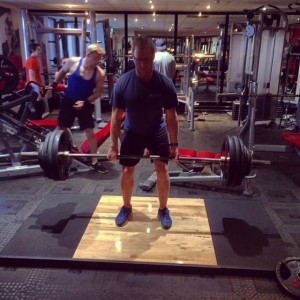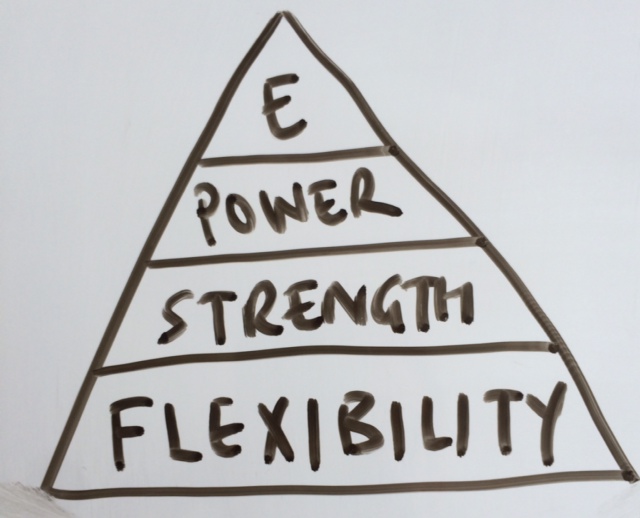The Importance of the Training Pyramid
The Fitness Training Pyramid
I know a guy who runs. His Facebook is full of his status updates about his running, his training, his races…..and more often than the others, his injuries. He must have spent more on physio treatment than race entries in the last two years.
Seriously. His physio must live in a castle with amount of work she gets from him.
His approach to training is to run. A lot. The problem is that he doesn’t do any other form of training so is chronically suffering from ankle, hamstring, hip and back problems. I used to live with him and he would NEVER stretch after his running, yet ignore the link between his training approach and his injury record.
He didn’t do any strength work either. His logic was he’s a runner, so why would strength training help? He needs to build endurance, not strength.
The thing is, all things being equal, strong muscles are able to withstand impact, generate force and avoid injury better. Furthermore, strength training doesn’t just train the muscles – it trains the bones and connective tissues too. Strength training makes you stronger and more robust. It doesn’t have to make you bigger and bulky.
With personal training clients who run, I make allowances in their training programmes for the extra work. We do extra core work, extra posterior chain strengthening and lots of stretching. I try to make their bodies more robust and able to cope with the running.
If you train properly you shouldn’t be picking up injuries so often. A training programme requires balance, planning, thought. It’s not just a collection of exercises thrown together, or one action repeated over and over again.
The training pyramid is a really helpful tool to understand some of the aspects of fitness, their importance and how they fit into the overall fitness training picture.
Lots of Yogi’s (people who practice yoga) do a similar thing to runners. They do lots of yoga and not much else. They may be able to tie themselves in a knot or balance on their head for an hour, but their real world, transferrable strength is non existent. Being able to hold a position of incredible balance may be impressive, but is it going to help you prevent back pain in later life? Probably not.
To be fit and remain healthy and injury free, you need a good combination of flexibility, strength, stamina and power. Your training needs to reflect that.
If you are strong as an Ox but can’t walk up the stairs without taking a rest, your training needs to change. Strength is pointless without the ability to use it!
Repetition leads to strain and injury unless it’s counter balanced. A couple of years ago I wrote this article and every word of it still stands.
My personal training client Suzi recently completed her first triathlon and did so without injury.
Why? Because she trained properly – her programmes were balanced, her recovery stretches were managed and she looked after herself. None of this is rocket science, it’s about making sure your training follows the training pyramid.
My infamous hand-drawn training pyramid diagram…!
Flexibility
All fitness should be built on a base of flexibility. That’s not to say you should spend more time stretching than anything else, but it certainly means you should be stretching to maintain healthy movement and prevent muscle and joint injury. A thorough stretch after every training session, plus a dedicated stretching session every week or two is a good start. Regular foam rolling is very beneficial too.
Strength
Once you have healthy movement, joints and flexibility it’s time to build strength. A solid base of strength is vital for exercise success and fitness performance. You build a house on strong foundations, you build your body on a foundation of strength. When you are strong you are less susceptible to injury, able to perform better and build power and endurance.
Power
There is some debate over what power actually is, but I refer to it as strength at speed. Your ability to move a weight (be it a barbell, dumbbell or even your own body) quickly. An explosive movement such as a box jump is an example of power. When it comes to training for power, it should only be done when a solid foundation of strength and flexibility has been established, otherwise you are much more susceptible to injury.
Endurance (E on the diagram)
Training for endurance should only start when you have covered the rest. Long duration work is the most damaging to the body – it’s higher rep, often higher impact, raises cortisol levels beyond levels seen with weight training and has the most shortening effect on the muscles and connective tissues.
The guy I mentioned at the top of this article went straight to the top of the pyramid when it came to his training and he suffered the consequences – injury after injury. My personal training client Suzi did her FIRST triathlon (when all of the specific triathlon training was new to her) yet didn’t pick up a single injury.
Why?
Because she did things properly. Everything was done the right way and she didn’t suffer as a result.
Maybe you are picking up injuries through your training and aren’t sure why. Take a look at your programme and ask yourself if you have followed the training pyramid. Have you taken care of your flexibility before doing anything else?
If you follow the training pyramid you won’t go wrong.
By the way, I’ve now started a VIP email list with discounts, offers, tips and news. You can subscribe at on my homepage! Click here to sign up (blue box at the bottom).

